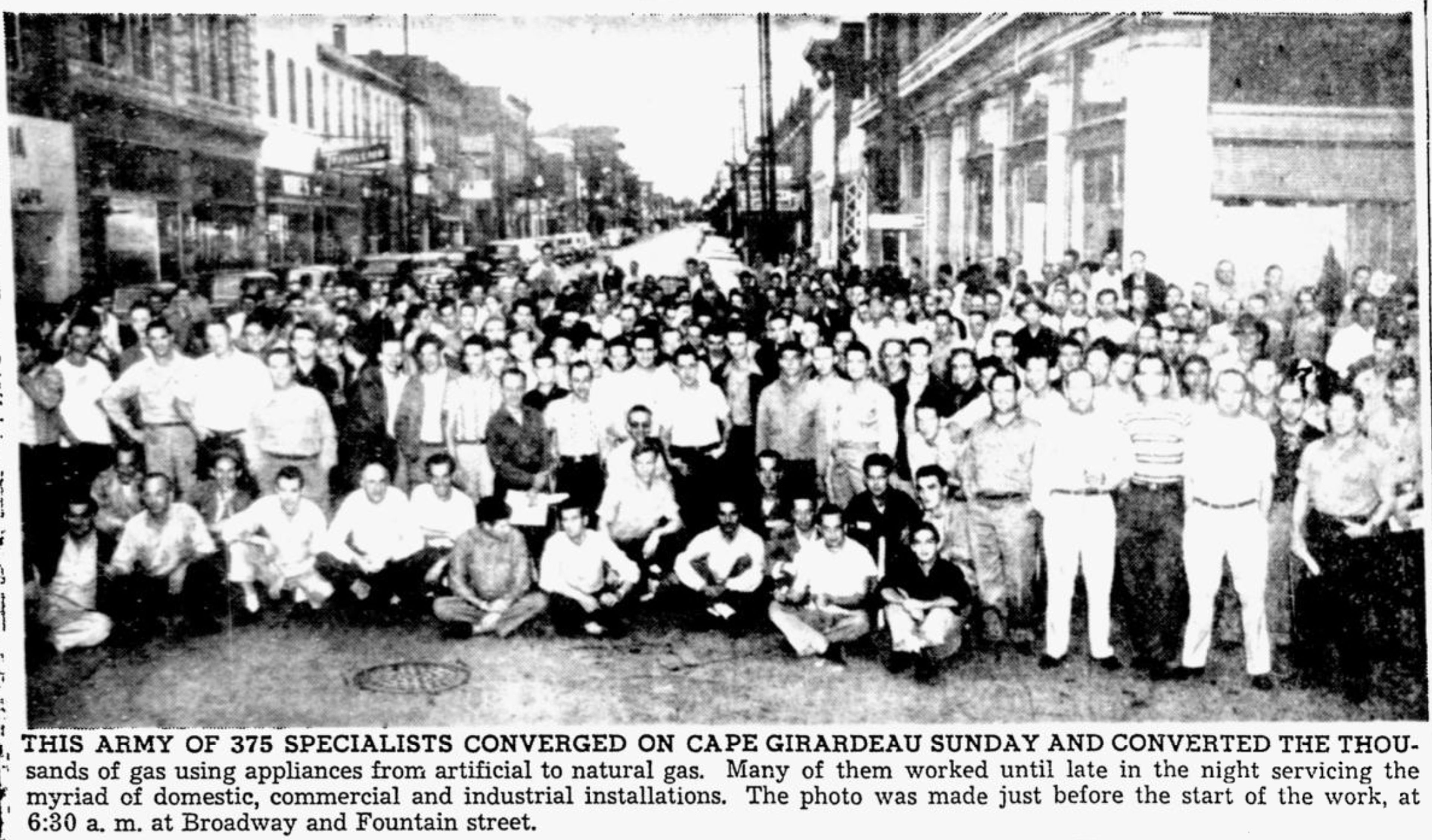Natural gas conversion makes history
Cape Girardeau made history on Sept. 18, 1949, with a groundbreaking one-day conversion of 1,875 gas customers from manufactured to natural gas. Discover how 375 workers achieved this monumental task.
Cape Girardeans have been “cooking with gas” since early in the 1900s.
On Feb. 10, 1905, the City Council passed an ordinance granting the Electric Lights and Water Co. an exclusive franchise for erecting a gas-manufacturing plant here and running mains to all the city’s “streets, alleys and highways.”
Records are incomplete, but it appears the plant near the city water works – consisting of a building containing the coal-burning apparatus to manufacture the gas, a gas-cleaning house and a storage tank – was completed and put into operation around 1907.
The plant was expanded and modernized over the years, and by 1927 a suggestion was made to pipe natural gas to Cape Girardeau. It would take another two decades for that talk to become a reality.
World War II appears to have put things on hold. As part of the war effort, however, the War Emergency Pipe Line – two lines, actually: the Big Inch and the Little Inch – carrying gasoline was built from Texas to Grays Point below Scott City. After the war, talk of piping natural gas to Cape Girardeau again began, this time making use of the “Inch” pipelines.
In October 1947, H.B. Newman, president of Missouri Utilities, announced that its application for natural gas service from the Inch pipelines had been approved. Missouri Utilities planned to service Cape Girardeau, Illmo, Fornfelt, Ancell and Dexter, if those towns voted franchises to the company. Cape Girardeau voters, by a margin of better than five to one, approved the agreement Nov. 30, 1948.
Mid-States Construction Co. of Mount Vernon, Illinois, under a contract with Missouri Utilities, began laying the pipe, an estimated 42,000 feet, in July 1949. Work progressed rapidly, and by the end of the following month the line had been completed between Illmo and Cape Girardeau, except for a few gaps where physical barriers had to be negotiated.
On Sept. 8, 1949, natural gas was flowing from the Inch lines to a distribution point on Hackberry Street in Cape Girardeau. Shortly afterward, plans were finalized for the conversion of all appliances in the city of Cape Girardeau using manufactured gas to natural gas.
Published Saturday, Sept. 10, 1949, in the Southeast Missourian:
Force of 400 to convert Cape to natural gas use
Sunday, Sept. 18 will be C-Day in Cape Girardeau. On that day an army of 350 to 400 men, armed with necessary tools and equipment, will make a door-to-door canvass of the city converting every manufactured gas appliance to use of natural gas.
Conversion Day plans were announced today by president H.B. Newman and vice president Leonard A. Byron of the Missouri Utilities Co.
The entire task of converting appliances will be done in the single day The company officials asked that every gas user in the city make arrangements to have somebody at home on the day designated until a man has called to make the conversion.
It is hoped, Mr. Newman said, to have every appliance in the city using gas converted before nightfall. The crews will begin their rounds at 7 a.m.
1,875 customers in town
There are 1,875 gas customers in the city, 1,723 residential and 152 commercial. There is no estimate of the number of appliances owned by the users.
The men assigned to the conversion project will come here from St. Louis, where they have been engaged in servicing 2,100 customers a day for Laclede Light and Gas Co.
All, Mr. Newman said, have been in the work for a lengthy period of time. They have been picked for their honesty, courtesy and ability to cope with any situation, he related.
A dispatcher will be here Thursday of next week to organize districts and arrange for dispatching orders. Each man on the conversion crew will be assigned six or eight customers.
Sounds warning
Mr. Byron warned that from the time the conversion begins at 7 a.m. until the converter arrives no appliance except top burners of gas ranges should be used.
One hundred maps have been prepared by utility company personnel to give to crew captains on C-Day. They designate to each man the addresses in each block where gas appliances are used.
At 4 a.m., three hours before the crews begin converting, natural gas will e turned into the Cape Girardeau distribution system. This will be done at regulator stations constructed at Sprigg Street and Washington Avenue and on Good Hope Street … and on Good Hope Street between Sprigg and Ellis streets.
Manufactured gas will be purged out of the system as it is pushed ahead of the natural gas flow to open valves at various points in the city.
Taking out old gas
The entire system, except for minute quantities in consumers’ pipes, will be glad of manufactured gas by this process. The converter, when he arrives, will burn off the remaining manufactured gas in consumers’ mains.
The actual conversion process consists of changing orifices in gas appliances. This is a tiny connection through which the gas passes to reach burners. Since natural gas is rich, compared to lean manufactured gas, smaller orifice openings must be inserted in appliances. In some cases the amount of air entering adjacent to the orifice must be regulated by attachments.
Mr. Newman stressed that this work is being done at company expense and will not be charged against the customer. He estimated that the one-day conversion job will cost the company between $25,000 and $30,000.
Special crew coming
In advance of residential, and some commercial, conversion, a special crew of men will be here on Saturday, Sept. 17, to change over laboratory equipment, gas appliances in schools and colleges, and equipment using gas in physicians’ and dentists’ offices.
Natural gas was allowed to move into the main line in the city Thursday for the first time. Prior to that it had been turned into the connection with the
Big and Little Inch Line for tests.
Pressure into city lines is regulated by the stem of stations which drops it at various points on the line to meet pressure standards as it moves into lateral lines in the city.

Published Monday, Sept. 19, 1949, in the Southeast Missourian:
Swift cut to gas for Girardeau
Cape Girardeau was cooking with gas today – natural gas – the result of an unprecedented one-day conversion job that took 375 men up to 10 o’clock Sunday night to complete.
It was a task that began promptly at 7 a.m., as scheduled, and moved without a hitch to near completion. Today the Missouri Utilities Co., which footed the $30,000 bill, reported that only 50 customers were away from home or were missed in the single-day project.
Crewmen told company officials that it was the first time in history that a city had been converted on one day. They considered it so unusual that a special articles is to be written for the gas industry trade journal telling how it was accomplished.
Company officials were elated over the smoothness with which conversion went over President H.B. Newman declared, “As a whole, we’re pretty happy about the whole thing. We found everyone cooperative.”
Old gas out
Natural gas first was pumped into the distribution center at 4:45 a.m. Sunday. Company workmen were stationed at various terminal points about the city and as the natural product moved into the line opened valves.
This allowed manufactured gas to flow out ahead of the natural kind. It was burned until natural gas had moved into all of the mains.
At 7 o’clock the crews of several men each, equipped with lists of consumers they were to visit, moved into the residential areas. That was when the big job began. In some places its took only a short time, but at others a longer period was required to make the changeover.
Some long hours
Mr. Newman said that the entire job lasted longer than had been anticipated because of a greater number of gas appliances in hoes than had been estimated. Particularly were there more hot water heaters than were expected, he said.
Because of these unforeseen contingencies, some crews worked until 10 o’clock Sunday night, as long as they could get in homes, too make the conversion.
Still help out
The 50 homes which were not converted were missed because no one was at home or because of inadvertency. Mr. Newman said that nine men remained over to work with local gas maintenance men to make these conversions and in making adjustments where necessary to appliances converted Sunday.
They will remain here as long as necessary, he said. Commercial gas appliances, and those in dentists’ and doctors’ offices were converted Saturday.
It took crews working at State College most of the day to make the changeover. The many Bunsen burners in the laboratories complicated the job, while gas ranges in the dormitories and elsewhere on the campus added to the task.
Special newspaper job
At The Missourian alternate crews worked until 2 a.m. today completing the conversion of machinery which uses gas. The large pot which melts lead for typesetting purposes required special orifices. Crews had none in their kits and an automobile was sent to St. Louis, where the Post-Dispatch had some spares. These were brought back to complete the work.
The Missouri Utilities will next begin work laying a pipe line from the Big and Little Inch lines to Dexter, where a complete new distribution system must also be laid. Mr. Newman said it is expected that this work will begin in October. It will be followed by lines in Illmo and Fornfelt, completing the company’s natural gas distribution system in this district.
Newman’s estimation of completion of the natural gas installation to the tri-city towns of Illmo, Fornfellt and Ancell proved too optimistic. Natural gas didn’t begin flowing in those towns until the spring of 1952.
Connect with the Southeast Missourian Newsroom:
For corrections to this story or other insights for the editor, click here. To submit a letter to the editor, click here. To learn about the Southeast Missourian’s AI Policy, click here.











